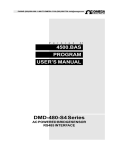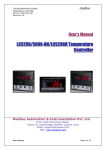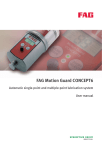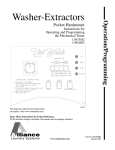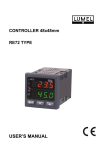Download Bernal Sensor-Line S 401 Instruction manual
Transcript
Instruction manual Sensor-Line S 401 Please keep this manual in a safe place. GB B 190.028-GB S 401 GB -1- 03-06 Index 1.0 Technical Data .................................................................................................... 3 2.0 General Instructions........................................................................................... 4 2.1 General safety instructions................................................................................ 4 2.2 Designated use ................................................................................................. 4 2.3 Indication for operating...................................................................................... 4 3.0 Drive assembly ................................................................................................... 6 3.1 Scope of supply................................................................................................. 6 3.2 Required tools ..................................................................................................... 6 3.3 Installation requirements ....................................................................................... 6 3.4 Assembly ............................................................................................................ 7 3.5 Installation......................................................................................................... 9 3.6 Initial operation................................................................................................ 13 3.6.1 Insert red/green light module.................................................................... 13 3.6.2 Functions and connections....................................................................... 14 3.6.3 Set-Up ...................................................................................................... 15 3.6.3.1 Adjustment of force and travel ........................................................................15 3.6.3.2 Individual adjustments.....................................................................................15 3.6.4 Perform safety check................................................................................ 18 3.6.5 Warning notices........................................................................................ 18 3.6.6 Radio ........................................................................................................ 18 3.6.6.1 Installation of the radio ....................................................................................18 3.6.6.2 Set-Up of the radio .........................................................................................18 3.6.6.3 Testing the radio .............................................................................................18 4.0 Maintenance...................................................................................................... 19 5.0 Demounting and disposal................................................................................ 19 6.0 Failure analysis................................................................................................. 20 7.0 Operating Instructions radio system PICO, 868,5 MHz ................................. 21 8.0 TÜV-Certificate.................................................................................................. 22 9.0 TÜV-Doors......................................................................................................... 22 10.0 EC-Manufacturer's Declaration ..................................................................... 23 11.0 EC- Manufacturer’s Declaration according to EC Directive........................ 24 12.0 Handing over................................................................................................... 24 S 401 GB -2- 03-06 1.0 Technical Data Description head variations S 401-60 S 401-80 standard circuit board optional red / green light module (red / green light red/ green, 230VAC, 50Hz, 1A) S 401-120 B 300.01 B 300.04 electric supply temporary peak load S 401-100 230 V / 50 Hz max. 600 N max. 800 N max. 1000 N max. 1200 N motor voltage 0 – 24 VDC circuit board voltage motor power max. 110 W max. 120 W max. 150 W max. 180 W tractive- /pressure power max. 600 N max. 800 N max. 1000 N max. 1200 N switch-on-time 30% speed (without load) max. 14cm/sec lighting 40W/230V (E14) duration of lighting 30-180 sec Radio (standard delivery) 868,5 MHz ambient temperature -20°C/ +40°C idle running – power loss fusible cut-out <1W F1:3,15AT/250V F1:3,15AT/250V F1:3,15AT/250V F1:3,15AT/250V F2:6,3AT/250V F2:6,3AT/250V F2:10AT/250V F2:10 AT/250V minimum mounting height 35 mm overall drive length 3,31 m head height 145 mm ca. weight (with 3,00m rail) ca. 18 kg travel path (with 3,00m rail) 2,40 m (with extension up to 5,4 m possible) max. area of door (smooth running, good balanced doors) S 401 GB 8 m² 10 m² -3- 12 m² 14 m² 03-06 You have to pay attention that the relevant national VDE-regulations for operating electrical appliances are strictly adhered to. We do not take any responsibility for the improper operating or maintenance of the door, accessories and the opener. 2.0 General Instructions This instruction manual is being released by BERNAL without any warranty. BERNAL reserves the right to make changes or modifications on the equipment at any time and on this manual without giving any prior notes. 2.2 Designated use The garage door opener is designed only for the operation with well-balanced swing- and sectional doors in the non-commercial sector. The recommended max. door measurements are listed under 1. Technical Data. The door has to be in accordance with the valid specifications (e.g. DIN EN 12604 and DIN EN 12605). Before mounting the opener, check that the door can to be easily moved by hand. 2.1 General safety instructions Important Safety Instructions: FOR THE SAFETY AND LIFE OF PERSONS IT IS ABSOLUTELY NECESSARY TO FOLLOW ALL INSTRUCTIONS. The opener is designed for the operation in dry rooms. KEEP THESE INSTRUCTIONS The garage ceiling has to be constructed, so that a safe attachment of the opener is assured. Qualified personnel should only perform the assembly and installation of the garage door opener. Faulty installation may lead to serious injuries! Disconnect power plug before any work on the device is done. (except on test and learning procedures) ! 2.3 Indication for operating For garages without a second entrance, a emergency release is necessary. A function test of the emergency release has to be carried out monthly! On installation the relevant regulations for the operational safety act / employers mutual insurance association have to be followed, e.g. UVV, DIN EN 60335-1 and VBG4. Do not hang on the cord of the emergency release with your weight! Make sure, that the emergency release of the opener does not collide with the roof rack or any protrusions of the vehicle or the door. The electro installation has to be performed by a qualified electrician, and has to conform to the relevant industrial safety regulations, according to DIN VDE 0100 and DIN VDE 0113. The power point must be easily accessible and at a max. distance of 50cm from the opener head. Instruct all persons, who are using the garage door and opener, about a safe and proper handling. Demonstrate and test the reversion (with a 50 mm high obstacle at max. 150 N) as well as the mechanical unlocking. Do not operate the garage door opener at all, until it is confirmed, that the garage door is in accordance with the safety norm 98/37/EG and a valid EC-Declaration of Conformity certificate is issued. . Operate the door only, when you can see the whole door area unobstructed. Pay attention, that there are no persons or any objects in the door operating area. Wait until the door stands still. Persons or vehicles are only allowed in door operating area, when the door is completely open and at standstill. An improper installation or any change to the opener without the manufacturers previous approval, any warranty or product liability is null and void. The installation has to be performed in accordance with this instruction. The installation of foreign elements endangers the safe operation of the opener and is not permitted. S 401 GB -4- 03-06 Do not permit children to play with the automated garage door. Transmitters are to be kept safe and away from children ! Fixed accessories (like key switch or similar) have to be attached in sight of the door. The accessory distance to the moving parts of the door, and at a minimum mounting height of 1,80m. Accessories have to be installed beyond the reach of children! Alert stickers against pen in have to be put close to the fixed key switch. Door, opener and extra installed safety accessories have to be checked regularly. See chapter 4 maintenance. Attention: The door can shut down faster with weak, broken or damaged springs or a defective counterweight. Under this circumstances using the emergency release may lead to uncontrolled movements of the door. When service- or adjustment work is urgently required, do not use the opener . A badly balanced door, or a faulty garage door drive may cause damage and injuries. S 401 GB -5- 03-06 3.0 Drive assembly CAUTION IMPORTANT INSTRUCTIONS FOR A SAFE MOUNTING ATTENTION – INCORRECT MOUNTING MAY LEAD TO SERIOUS INJURY – ALL MOUNTING INSTRUCTIONS HAVE TO BE FOLLOWED Fig.1 3.1 Scope of supply The scope of supply, as shown on the Fig. 1 and 2, may vary according to the drive version. 3.2 Required tools For the assembly und mounting of the drive the tools shown in Fig. 3 are required (not in the scope of supply). Fig. 2 3.3 Installation requirements The garage door opener is suitable for the automation of spring balanced swing doors (Fig. 4a) and sectional door (Fig. 4c). (max. sizes see 1.0 technical data). For an optimal attachment of the push rod to the sectional door, a sectional door attachment is available as an accessory. For doors, that are non-protruding up-andover, a curved arm is available as accessory. (Fig. 4b) For the mounting a minimum lintel height of 35 mm is necessary (Fig. 4). Fig. 3 Fig. 4 S 401 GB -6- 03-06 3.4 Assembly Pre-assembly of rail According to the version, the rails have to be pre-mounted as requirements. Put the rails together via the connection rail. (Fig. 5) Slide the rails together to the stop position. Pull the rear bracket (Fig. 6.1) together with the belt (Fig. 6.2) out of the rail. Remove the transportation covering (Fig. 6.3) and press the pinion (Fig. 6.4) into the bearing. Take care of the belt not being squeezed. Then attach the transportation covering again and push the complete rear bracket back into the rail. Fig. 5 Adjust the tension of the chain or belt by pulling the idler wheel towards the chain end. Make sure, that the chain lock (Fig. 7a) is on the left side of the rail. (Fig. 7) Then push the tensioning bracket towards the end of the chain and guide the coach bolt through the hole of the tensioning bracket. Pay attention that the coach bolt fits into the tensioning bracket. Push the provided spring and washer on the end of the coach bolt and screw the nut on the coach bolt. (Fig. 8) Fig. 6 Paste rubber buffers If you have a chain drive, we recommend sticking the provided rubber buffers to the inside of the rail (Fig. 9c). Those serve to minimize the noise caused, when the chain touches the rail. Assure, that the rubber buffers are not in the travel path of the trolley. The buffers have to be put close to the end of the chain, so that the trolley doesn’t touch them in door-closed- (Fig. 9a) or in door-open-position (Fig. 9b). Fig. 7 Fig. 8 Fig. 9 S 401 GB -7- 03-06 Pre-tension chain / belt Turn the nut to tension the chain or belt slightly. Fig. 10). Trolley test Check afterwards, that the trolley can easily be moved by hand. To release the trolley, from the chain lock, pushes the lever on the trolley and at the same time move the trolley in the rail (Fig. 11). Make absolutely sure, that after this test the trolley engages on the chain lock. To perform this, move the trolley without holding the lever over the chain/belt lock and the trolley engages automatically. Fig. 10 Assembly of door bracket According to the installation situation the provided push rod components can be combined as needed (Fig. 12). If the length of the push rod is not sufficient, it can be adjusted via the extension rod (Fig. 12a). In adoption with sectional doors, we recommend the use of a sectional door angle (Fig. 12c). Then the provided door bracket (Fig. 12b) has to be attached to the push rod. For the assembly use the provided screws, washers and nuts, and tighten them firmly. Fig. 11 Fig. 12 S 401 GB -8- 03-06 3.5 Installation CAUTION Before installing the drive all mechanical locks of the door have to be put out of order! Mark the middle of the door Measure the width of the door and mark the middle of the door at the lintel. (Fig. 13) Calculation of the necessary height The rail has to be mounted on such a height, that between the highest door point (Fig. 14.1) (the highest point that the door can reach during the movement) and the lower edge of the rail, a clearance of at least 10-20 mm is available (Fig. 14.2). Pay attention, that the rail is always mounted at a level position. Fig. 13 The angle a (Fig. 15) may not exceed 30°; otherwise a correct transmission of the power is not guaranteed. The distance between the lower edge of the rail and the upper edge of the garage door should be between 5 and 7 cm in closed condition. Fig. 14 Fig. 15 S 401 GB -9- 03-06 Mounting the lintel bracket Extend the door measurements on the lintel, so that the provided head bracket (Fig. 16) is exactly in the middle of the door and above the required highest door position. Use a pen and mark the bracket holes on the lintel and drill the required holes (Fig. 16). Attention: When drilling, cover the drive! Then attach the lintel bracket (Fig. 17) to the lintel. (depending on the installation situation the provided fastening screws have to be replaced by others). Attaching the rail to the head bracket Then fasten the rail to the lintel bracket with a coach bolt and a lock nut (Fig. 18). Fig. 16 Fig. 17 Fig. 18 S 401 GB - 10 - 03-06 Fixing of the retaining angle Bring the rail in a level position, fit the retaining angles to the return head. Make sure, that the rail is in a level position. The excess lengths of the angles have to be sawed off (Fig. 19). Attachment of the rail Afterwards mark the points where the retaining angles shall be attached to the ceiling. Make sure, that the rail is aligned with the earlier marked middle of the door. Drill the required holes and affix the retaining angles to the ceiling (Fig. 20.1). Attention: When drilling, cover the drive! Attachment of the drive head The next step is to insert the drive head shaft on the collet of the return head (Fig. 20.2). As shown in Fig. 20.3 the drive head has to be attached with the 2 Phillips-screws and spring washers to the return head. Fig. 19 Abb. 20.1-20.3 S 401 GB - 11 - 03-06 Adjust the tension of chain or belt Turn the nut of the tension unit (Fig. 21), so that the spring is completely compressed. Than release the tension of the spring by turning the nut back about 1 to 2 turns, until the chain or belt can be pushed together to approx. 0,5 cm distance in the middle of the rail. Attachment of the door bracket assembly First press the lever on the trolley, (Fig. 22.1) and move the trolley towards the lintel. Then mark the points of the door, where the door bracket shall be attached (Fig. 22.2). Drill the required holes at the door and attach the door bracket, with 2 screws, firmly to the door (Fig. 22.3 + 22.4). Fig. 21 Installing the emergency release If the garage is without a second entrance, the installation of a emergency release set is absolutely necessary, so that in case of an emergency the door can be opened from outside. The Bowden cable has to be moved through the eye of the „key shaft“ and the mantle. (Fig. 23.1 + 23.2) Afterwards the linkage has to be moved through the door bracket (Fig. 23.2). At the end of the installation of the Bowden cable has to be attached at the door handle (Fig. 23.3). It is absolutely necessary, to check the correct function of the emergency release, before using the garage door opener. Fig. 22 Before operating the garage door opener: unlock the trolley and open and close the door to the full stop by hand. The trolley has to come to a full stop, before bumping the drive head or the return guide assembly, with the door in open / closed position. Fig. 23 S 401 GB - 12 - 03-06 3.6 Initial operation 3.6.1 Insert red/green light module If you want to insert the red/green light module, you have to do the following steps: CAUTION Before removing the light cover - disconnect the power plug! 230V ~ At first, the 2 safety screws have to be removed as shown in Fig. 24.1 and the light cover has to be taken off. Then turn out the light bulb and the 4 screws of the cover (Fig. 24.2). Now the cover can be taken off (Fig. 24.3) and the red/green light module can be inserted (correct position see Fig. 25 circuit board layout). The red/green light module has to be attached with the provided screws on the circuit board, and the heads of the screws have to be isolated with the provided plastic covers (Fig. 24.4). CAUTION The heads of the screws must be isolated with the plastic covers. The screws are under 230 V mains voltage! Then break out the pre-punched notch for the red/green light module in the cover and reassemble the cover – screws – light bulb and light cover. Now plug the opener to the mains. S 401 GB Abb. 24.1-24.4 - 13 - 03-06 If the light barrier is activated during door closing, the drive stops and reverses (completely or partially, according to the setting on the circuit board, menu point b1). If there is an activation while the door opens, there is no reaction. CAUTION: During the learn function, the light barrier is not activated. 3.6.2 Functions and connections The assembly as well as the connection- and adjustment possibilities of the circuit board are shown in Fig. 25. For the activation and set-up of some connections (for example, light barrier, safety edge, etc.) some individual adjustments as described in paragraph 3.6.3 have to be implemented. Connection safety edge 8,2 or 22 kOhm When using a safety edge, the menu point b sub point 5 has to be set on 1 (=active). If there is no light barrier connected simultaneously (menu b sub point 4 =inactive) the safety edge has to be just connected on terminal 7 and 8. With an additional connected light barrier, the safety edge has to be connected in-line with the receiver signal of the light barrier (terminal 7) (in menu b the light barrier and the safety edge have to be activated). The standard circuit board B 300.01 has the following connection possibilities and functions: Start button external terminal 1 (earth) and terminal 2 (signal) The start button on the circuit board, the start button external and the radio receiver have the same function during operation (exception: learn function). With the start button the drive can be started and stopped. During door movement, pressing the start button activates the soft-stop. Isolated normally open output for doorclosed contact or connection warning lamp on automatic closing terminal 9 and 10 230VAC / max 1A cos Phi = 1 30VDC/ max.1A The external wires have to be protected with max. 1A delay fuses. a) Red / green light module is not installed: When setting menu point b3 (automatic closing) on 0 (=inactive) the clamps 9 and 10 are the door-closed contact. When setting b3 on 1 (=active) the terminals 9 and 10 are a isolated normally open output for a warning lamp for automatic closing. b) Red / green light module installed (optional) The clamps 9 and 10 are generally door-closed contact. Emergency stop terminal 3 and terminal 4 Wire jumper bridges terminal 3 and 4, if the emergency stop is not connected. Activating the emergency stop during door open movement, the drive is immediately stopped; when activating while the door closes, the door stops immediately with reversion. If you are using a slip door, a fail safe slip door contact has to be applied. The connection cable has to be laid fail safe. (e.g. with cable type: ÖLFLEX-CLASSIC-100 2x,5mm²). Light barrier with integrated check according to safety category 2 EN 954 transmitter: terminal 5 (+): 80 mA / 24 V terminal 6 (-): switched earth receiver: terminal 5 (+): 80 mA / 24 V terminal 7 (S): signal terminal 8 (-): earth The setting of the pre-warning period automatic closing is possible on menu point U or H (when red / green light module is plugged). The automatic closing period (opening period) can be set on menu point A. Light barrier is not connected: terminal 7 and 8 are open, Menu b sub point 4 has to be set on 0 (=inactive).When using a light barrier: menu b sub point 4 has to be set on 1 (= active). The receiver is always connected to the mains voltage. The transmitter is only active when the drive is working. When the drive is activated, the transmitter of the light barrier receives his voltage. The receiver is being activated via the transmitter diode and the signal of the light barrier is switched on. Before every start the function of the light barrier is being controlled. If there occurs an error on the light barrier, there is no start possible! S 401 GB External lighting terminal 15 and terminal 16, 230 VAC/60W (max.) After every start, according to the set adjustment time at menu L, the internal and external light is on. Connection earth terminal 17 Earth e.g. for external lighting Connection antenna to terminal 25 and 26 To avoid interferences with the circuit board we recommend generally: when using a pluggable receiver (MOLEX 10-pol), connect the antenna directly to the receiver. If this is not possible, a rod antenna can be connected to clamps 25 and 26. Attention: Operates only in connection with a receiver plugged in the MOLEX-socket. - 14 - 03-06 Start (button on the circuit board) 1. Starting and stopping of the drive 2. Controls the drive during the learn function (see menu). 3.6.3.1 Adjustment of force and travel For start-up procedure of the garage door opener, it is absolutely necessary, to learn the force and the travel path once (menu point P). Lighting internal 230 V / 40 W E14 Adjustment of the lighting period see menu point L. Follow the particular steps as shown in Fig. 26 (left side). During the learning period, the end stops and the necessary power at the different points of door travel, are being defined by the hallsensor and saved on the circuit board . After the learning process, a test run should be performed. Slot radio receiver 10-pin MOLEX plug socket Soft travel Before reaching the limit stops and breakpoints the soft travel is activated. An optimal, soft starting and stopping of the door is achieved. After any change in the soft travel set-up a new power- and travel learning is necessary. CAUTION: Make sure, that the dynamic closing power does not exceed 400N! During the learning process, no analysis of the light barrier and the overload is performed. If the learning process is interrupted by emergency stop, pulse length exceeding (e.g. connection for pulse generator is missing) or start button, the complete learning process has to be repeated. Optional module: red / green light module terminal 11 to 14 2 relays (red, green) are provided for the red / green light module. red : terminal11(PH) green : terminal 13(PH) terminal12(N) terminal 14(N) The pre-warning time for opening and closing is adjustable at menu point H. At menu point b sub point 6 red light can be switched to permanent lighting or blinking. After every power failure with activated red / green light, the previous condition is being restored. At status prewarning, when the voltage returns, the prewarning period is cancelled. Manual adjustment of the power values If you notice after the performed test run, that the power has to be changed again, that can be adjusted at menu point F (Fig. 26, right side). Thereby increase step by step the value of F until the test-run is possible without power shut off. CAUTION: Make sure, that the dynamic closing power does not exceed 400N! Function cycle of the red / green light control Opening: 1. Door is closed 2. Start impulse 3. Pre-warning period on: red / green light blinks or is permanently on (according to adjustment) 4. Door opens: red light permanently on 5. Door is open: green light on 3.6.3.2 Individual adjustments At the menu points F to b (Fig. 26, right side) further individual adjustments can be set: Menu point F: Adjust the value of switch-off power at the main door closing edge (preset value 5). Menu point H: Adjust the pre-warning time, (option) red / green light; only active, if red / green light module is installed and b3 not active (preset value 4 sec.) Closing: 1. Door is open 2. Start impulse or automatic closing 3. Pre-warning period on: red / green light blinks or is permanently red (according to adjustment) 4. Door closes: red light permanently on 5. Door closed: red / green light off Menu point A: Adjust automatic closure period, only possible if menu point b3 is active (preset value 10 sec.) Menu point U: Adjust automatic closure pre warning period , only possible if menu point b3 is active (preset value 4 sec.) 3.6.3 Set-Up The menu structures of the different adjustment possibilities are shown in Fig. 26. Attention: After plugging the unit to the mains wait until the green LED is permanent on, then start set-up. After pressing the menu button (about 5 sec.) you get to the menu functions. With the scroll button you can jump from one menu point or adjustment value to the next one. When the desired menu point or value is reached on the display, it has to be confirmed by pressing the enter button. For leaving the menu press the scroll button until it reaches the menu point E and then confirm with the enter button. S 401 GB Menu point L: Adjustment lighting period (preset value 180 sec.) Menu point b: Addititional binary functions 1. Reversion (0: full, 1: 10 cm) 2. Soft travel (0: 7 cm, 1: 15 cm) 3. Automatic closure (0: inactive, 1: active) 4. Light barrier (0: inactive 1: active) 5. Safety edge (0: inactive, 1: active) 6. Warning light (0: blinking, 1. permanent light) 7. Load preset values (grey values) - 15 - 03-06 Fig. 25 S 401 GB - 16 - 03-06 Fig. 26 S 401 GB - 17 - 03-06 3.6.4 Perform safety check For the safety of persons and objects, a safety check has to be performed. Before finishing the initial operation make sure that the drive stops and reverses according to the valid norms (EN 12453). When reaching an obstacle (max. 150 N force = ca. 15 kg, above an opening width of 50 mm) the door has to stop and reverse - completely or partial, depending on the adjustment on the circuit board. This test and measurement of force can only be performed by a professional. If the door does not move the right way or does not reverse when reaching an obstacle, the force and travel adjustments have to be repeated (chapter 3.6.3.1, menu point P and Fig. 26). If the shutdown force is too low or too high, at menu point F (chapter 3.6.3.2 and Fig. 26) the force has to be set correspondingly. Afterwards repeat the test. If the door, after the performed corrections does not stop and reverse according to the valid norms, the door may not be operated automatically. Fig. 27.1-27.2 3.6.5 Warning notices Warning notices against pen in have to be placed at an eye-catching place or near to the drive (Fig. 28). 3.6.6 Radio 3.6.6.1 Installation of the radio If your drive is not fitted with a factory equipped radio system, the receiver has to be fitted to the circuit board. To fit the receiver, the light cover has to be taken off (Fig. 27.1), then plug the receiver on the 10-pin molex socket a) as shown in Fig. 27.2. Fig. 28 3.6.6.2 Set-Up of the radio According to the radio system used, the set-up operation of the radio can be different. For the standard radio system PICO there is a description in the annex of this manual. 3.6.6.3 Testing the radio The first function test of the radio should be performed generally inside of the garage (Fig. 29.1). Test the radio twice inside the garage. After successful performance, go in front of the garage and test the radio again twice (Fig. 29.2). Fig. 29.1-29.2 S 401 GB - 18 - 03-06 4.0 Maintenance We recommend, that the door system be checked once a year by a professional. The force shutdown, possibly installed safety equipment and the emergency release have to be checked every 4 weeks and have any possible failures repaired immediately by an professional. The force shut-off can be tested, by putting a 5 cm or higher piece of wood on the floor, in the travel path of the door (Fig. 30). Now close the door . When reaching the obstacle, the door has to stop and reverse (completely or partially, according to the performed setting on the circuit board). Fig. 30 CAUTION Before taking the cover off, disconnect the power plug 230V ~ If an exchange of single components (e.g. circuit board, motor, etc.) of the drive is necessary, first remove the light cover. For that purpose remove both safety screws as shown in Fig. 31.1. After removing the light cover turn out the bulb. Afterwards remove the 4 screws of the cover (Fig. 31.2) and take it off (Fig. 30.3). When exchanging the bulb, only a bulb with max. 40 W (E14) may be used. Batteries and bulbs are not included in warranty claims. After finishing the repairs, put back all parts in reverse order. 5.0 Demounting and disposal For demounting and disposal the local safety and disposal regulations have to be followed. Fig. 31.1-31.3 S 401 GB - 19 - 03-06 6.0 Failure analysis Lighting: • bulb defective: exchange with 40W/ 230V E14 bulb • drive is without mains voltage: • check power plug and fuses and exchange if necessary Radio system: • door does not run with transmitter check the battery of the transmitter and exchange if necessary. receiver has not learned the code of the transmitter, repeat learning process. • range is dissatisfying: check the connection and the location of the antenna and correct if necessary. check the output of the battery and exchange if necessary. use a rod aerial. circuit board: • door does not move: check, if the safety inputs are jumpered or safety installations are installed and not connected. • door only reacts with push button: check the placement of the receiver and exchange if necessary. • door stops while travelling: door is too tight, check the door mechanic and renew if necessary (only by a professional !!) • door reverses while moving: check if there is an obstacle in the travel path and remove the obstacle. motor: • motor runs, but the door does not move: check the connection between push rod and door and correct if necessary, check if the trolley is engaged in the chain/belt lock? • motor jerks: motor gearbox defective, exchange complete motor unit • motor does not start • check, if the hallsensor cable is connected correctly (at the motor and at the circuit board): S 401 GB - 20 - 03-06 Function: 7.0 Operating Instructions radio system PICO, 868,5 MHz Transmitting direction T1 T3 T2 T4 Application: remote control for garage door and gate openers Technical data: - Frequency 868,5 MHz - Coding: KEELOQ®-Rolling Code System; pre-programmed by the factory - each receiver has a max. capacity of 28 transmitters, which can be programmed - Power supply: standard 3 V CR2032 lithium coin cell - Range approx. 50 m, depending on the surroundings Battery replacement: Hybrid receiver 4-pole (S 401) Programming: 1. push the learn button on the PCB until the display shows a „L“ flashing 2. push the transmitter button, „L“ lights up short-time and then starts flashing again 3. push the transmitter button again, „L“ lights up for about 3 s, then it disappears 4. the programming mode is finished automatically, the radio system is ready for use pluggable MOLEXreceiver (10-pole) Programming: 1. push the learn button on the receiver short-time, the green LED lights up 2. push the transmitter button, the green LED extinguishes 3. push the transmitter button again, the green LED flashes for about 5 s and then extinguishes 4. the radio system is ready for use Erasure: Keep the learn button pushed down for about 5 s, „L“ lights up and then extinguishes, all transmitters are erased Erasure: Keep the learn button on the receiver pushed down for about 10 s, until the green LED extinguishes, all transmitters are erased Loosen the battery cap on the rear side of the casing by turning it to the left side (see drawing) with your finger. Insert the new battery with its positive pole forward into the battery cap. Turn the battery cap together with the battery back into the casing. IMPORTANT: Do not throw used batteries into domestic waste; dispose them through battery recycling system! Transmitter types: 2- and 4-channel Conformity: The radio system conforms to the standards EN300220-3 V1.1.1; EN301489-3 V1.4.1; EN60335-1; EN50371 and may be put in circulation without additional registration in the countries of the EU and in Switzerland. HomeLink®-compatible: The HomeLink®-System integrated in some car types can also be programmed with this transmitter provided that the software-version of the HomeLink®-System is version 8 or higher. S 401 GB - 21 - 03-06 8.0 TÜV-Certificate 9.0 TÜV-Doors S 401 GB - 22 - 03-06 10.0 EC-Manufacturer's Declaration S 401 GB - 23 - 03-06 11.0 EC- Manufacturer’s Declaration according to EC Directive We, the company..……………………………………………………………..……. ..............................................................…….......................... declare that the garage door installation conforms to the following EC directives: 98/37/EC Machine directive appendix II The component doors drive S 401 .................……..………... is in the garage door installation, supplied by: ……………………………………. ...............................………………….... Type: ......................…................ Height: .......................…........cm Width: ......……..........….….....cm integrated. Date: ...................................... Signature: .......................................... 12.0 Handing over of the garage door drive Type: ....................................... and the corresponding Instruction manual Customer's address Handing over date Signature of customer S 401 GB - 24 - 03-06
























